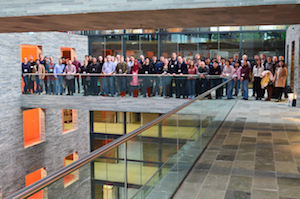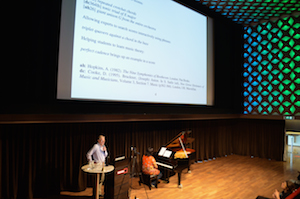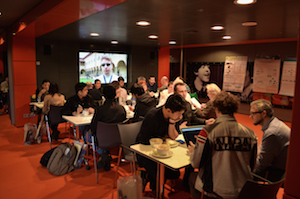MediaEval 2016 Report
01/01/17 12:00
The Benchmarking Initiative for Multimedia Evaluation: MediaEval 2016
Published in IEEE Multimedia
The Benchmarking Initiative for Multimedia Evaluation: MediaEval 2016 The Benchmarking Initiative for Multimedia Evaluation (MediaEval) organizes an annual cycle of scientific evaluation tasks in the area of multimedia access and retrieval. The tasks offer scientific challenges to researchers working in diverse areas of multimedia technology— including text, speech, and music processing, as well as visual analysis. MediaEval tasks focus on the social and human aspects of multimedia. In this way, the benchmark supports efforts of the research community to tackle challenges linked to less widely studied user needs. It also helps researchers investigate the diversity of perspectives that naturally arise when users interact with multimedia content.
Once MediaEval task participants have developed algorithms and written up their results, they come together at the yearly workshop to report on and discuss their outcomes, synthesize their findings, and plan new evaluation tasks and strategies to help advance the state of the art. Here, we present highlights from the 2016 workshop.
A Multimedia Venue
The 2016 MediaEval workshop was held in the Netherlands, right after ACMMultimedia 2016, in Amsterdam. The workshop was hosted by The Netherlands Institute for Sound and Vision, located in Hilversum, about 30 km from Amsterdam (http://www.beeldengeluid.nl/en). The mission of the institute is to collect and preserve the audiovisual cultural heritage of the Netherlands and to make it open and available for as many users as possible. The institute’s archive contains nearly a million hours of television, radio, music, and film, from 1898 through today. The archive is housed in a depot that is five stories deep: an amazing architectural feat for the Netherlands with its proximity to sea level.
Even to the casual visitor, the architecture of the Netherlands Institute for Sound and Vision is striking. The facade is covered with colored glass panels that let through light. These panels are based on nearly 800 different images stored in the archive. They combine relief images with bright colors and were created through a specially designed process (see Figure 1a).
The MediaEval 2016Workshop was attended by 65 participants from 23 countries (see Figure 1b). The participants submitted algorithms that addressed nine tasks. (See http://ceur-ws.org/Vol-1739 for the full proceedings.) The workshop consisted of oral and poster presentations. (See http://multimediaeval.org/video for videos of the task overview talks.)


Figure 1. The MediaEval 2016 Workshop. (a) Held at the Netherlands Institute for Sound and Vision (Photo by Hay Kranen CC BY 4.0 via Wikimedia Commons), the workshop had (b) 65 participants from 23 countries.
A highlight of the workshop was the invited talks. Evangelos Kanoulas, from the University of Amsterdam, Netherlands, talked about information retrieval evaluation and “putting the user back in the loop.” Julian Urbano, from the Universitat Pompeu Fabra, Barcelona, discussed music information retrieval evaluation [1]. Also, Maria Eskevich, from Radboud University Nijmegen, Netherlands, and Robin Aly, from the University of Twente, Netherlands, presented the “TRECVid Video Hyperlinking” task.
MediaEval Shared Tasks
Each year, the MediaEval campaign offers a number of carefully selected and designed evaluation tasks. The tasks are proposed and also coordinated by autonomous groups of task organizers. Each task comprises a definition, a dataset, and an evaluation procedure. The task-selection process is driven by a large community survey. For a task to be selected, it must match MediaEval’s objective of focusing on the human and social side of multimedia, be well designed and feasible, and demonstrate evidence of community interest, as measured by the survey.
Social Multimedia
A first set of tasks asked participants to address challenges raised by social multimedia. The Placing task required participants to estimate the location of multimedia items using user=contributed metadata or content. The task used a subset of the Yahoo Flickr Creative Commons 100Million (YFCC10M) dataset [2]. The Retrieving Diverse Social Images task required participants to refine Flickr query photo results to improve relevance and diversity. The task provided visual, text, and user-tagging- credibility-related features in order to address a broader research community. Finally, the Verifying Multimedia Use task tackled the problem of images and videos that are shared online (Twitter) but fail to provide a faithful representation of a real-world event.
User Impact
A second set of tasks tackled the challenge of making predictions related to the impact of multimedia on viewers or users. The Emotional Impact of Movies task required participants to predict emotions evoked in viewers. The data consisted of Creative Commons-licensed movies (professional and amateur) together with valence-arousal ratings collected from annotators. The Predicting Media Interestingness task was new for 2016. This task required participants to automatically select frames or portions of movies that are the most interesting for a common viewer. To solve the task, participants could use the provided visual, audio, and text content. Finally, the Context of Multimedia Experience task looked at the suitability of video content for consumption in particular viewing situations. Participants were asked to use multimodal features to predict videos that viewers would rate as suitable for watching on an airplane.
Getting More out of Multimedia
A third set of tasks was devoted to tackling unsolved problems that push beyond the ways in which multimedia is currently used or multimedia collections are accessed. The Person Discovery in Broadcast TV task asked participants to tag TV broadcasts with the names of people who can be seen as well as heard. The task differs from similar tasks in that the list of possible people is not known a priori and their names must be discovered in an unsupervised way. The Zero-Cost Speech Recognition task reposed the question of how to train an automatic speech recognition system. Instead of assuming that the data is a given, finding data was considered to be part of the challenge. The cost of data and the error rate of the system were minimized together.
Finally, C@merata (the Querying Musical Scores with English Noun Phrases task) addressed the problem of information retrieval from a collection of musical scores. Effective solutions require combining knowledge of music, natural language processing, and information retrieval (see Figure 2a).


Figure 2. The Netherlands Institute for Sound and Vision made it possible to (a) demonstrate music queries on a Steinway during the C@MERATA presentation and (b) show videos from past years during discussion and lunch.
MediaEval is a grassroots initiative that runs without a parent organization. The success of MediaEval is possible due to the hard work of the task organizers and the dedication of the task participants. Hours of intense discussions are needed at the workshop (see Figure 2b) and throughout the year. In 2017, theMediaEvalWorkshop will be co-located with Conference and Labs of the Evaluation Forum(CLEF 2017), to be held in September at Trinity College in Dublin, Ireland (http:// clef2017.clef-initiative.eu). Registration to participate in MediaEval 2017 will run from approximately March to May 2017 (see http:// multimediaeval.org).
The tasks offered by MediaEval 2017 will likely be a mix of classic and innovative tasks. We anticipate new developments in the areas of music, medical multimedia, and also in the combination of social multimedia and satellite images [3] medical multimedia [4] and music [1]. MM Acknowledgments Support for the MediaEval 2016 workshop was provided by Elias Evaluating Information Access Systems (http://elias-network.eu), friends of ACM SIGIR (http://sigir.org), Technicolor (http://www.technicolor.com), Simula Research Laboratory (http://www.simula.no) and the Netherlands Institute for Sound and Vision (http://www.beeldengeluid.nl). MediaEval connects to the speech processing community by means of the SIG Speech and Language in Multimedia of the International Speech Communication Association (http://slim-sig.irisa.fr). We would also like to thank the 2016 task organizers and participants. A special thank you goes to Andrew Demetriou for the effort he invested in making the 2016 workshop a success and to his dedication to supporting multimedia research in crossing disciplinary boundaries.
References
[1] B. McFee, E. Humphrey, and J. Urbano, “A Plan for Sustainable MIR Evaluation,” Proc. 17th Int’l Society for Music Information Retrieval Conf. (ISMIR), 2016, pp. 285–291.
[2] B. Thomee et al., “YFCC100M: The New Data in Multimedia Research,” Comm. ACM, vol. 59, no. 2, 2016, pp. 64–73.
[3] A. Woodley et al., “Introducing the Sky and the Social Eye,” Working Notes Proceedings of the MediaEval 2016 Workshop, 2016; CEUR-WS.org/Vol-1739/MediaEval_2016_paper_9.pdf.
[4] M. Riegler, “Multimedia and Medicine: Teammates for Better Disease Detection and Survival,” Proc. 2016 ACM Multimedia Conf. (MM), 2016, pp. 968–977.
This summary brought to you by the MediaEval 2016 Community Council:
Martha Larson Radboud University Nijmegen
Mohammad Soleymani University of Geneva
Guillaume Gravier IRISA
Bogdan Ionescu University Politehnica of Bucharest
Gareth J.F. Jones Dublin City University
Published in IEEE Multimedia
The Benchmarking Initiative for Multimedia Evaluation: MediaEval 2016 The Benchmarking Initiative for Multimedia Evaluation (MediaEval) organizes an annual cycle of scientific evaluation tasks in the area of multimedia access and retrieval. The tasks offer scientific challenges to researchers working in diverse areas of multimedia technology— including text, speech, and music processing, as well as visual analysis. MediaEval tasks focus on the social and human aspects of multimedia. In this way, the benchmark supports efforts of the research community to tackle challenges linked to less widely studied user needs. It also helps researchers investigate the diversity of perspectives that naturally arise when users interact with multimedia content.
Once MediaEval task participants have developed algorithms and written up their results, they come together at the yearly workshop to report on and discuss their outcomes, synthesize their findings, and plan new evaluation tasks and strategies to help advance the state of the art. Here, we present highlights from the 2016 workshop.
A Multimedia Venue
The 2016 MediaEval workshop was held in the Netherlands, right after ACMMultimedia 2016, in Amsterdam. The workshop was hosted by The Netherlands Institute for Sound and Vision, located in Hilversum, about 30 km from Amsterdam (http://www.beeldengeluid.nl/en). The mission of the institute is to collect and preserve the audiovisual cultural heritage of the Netherlands and to make it open and available for as many users as possible. The institute’s archive contains nearly a million hours of television, radio, music, and film, from 1898 through today. The archive is housed in a depot that is five stories deep: an amazing architectural feat for the Netherlands with its proximity to sea level.
Even to the casual visitor, the architecture of the Netherlands Institute for Sound and Vision is striking. The facade is covered with colored glass panels that let through light. These panels are based on nearly 800 different images stored in the archive. They combine relief images with bright colors and were created through a specially designed process (see Figure 1a).
The MediaEval 2016Workshop was attended by 65 participants from 23 countries (see Figure 1b). The participants submitted algorithms that addressed nine tasks. (See http://ceur-ws.org/Vol-1739 for the full proceedings.) The workshop consisted of oral and poster presentations. (See http://multimediaeval.org/video for videos of the task overview talks.)


Figure 1. The MediaEval 2016 Workshop. (a) Held at the Netherlands Institute for Sound and Vision (Photo by Hay Kranen CC BY 4.0 via Wikimedia Commons), the workshop had (b) 65 participants from 23 countries.
A highlight of the workshop was the invited talks. Evangelos Kanoulas, from the University of Amsterdam, Netherlands, talked about information retrieval evaluation and “putting the user back in the loop.” Julian Urbano, from the Universitat Pompeu Fabra, Barcelona, discussed music information retrieval evaluation [1]. Also, Maria Eskevich, from Radboud University Nijmegen, Netherlands, and Robin Aly, from the University of Twente, Netherlands, presented the “TRECVid Video Hyperlinking” task.
MediaEval Shared Tasks
Each year, the MediaEval campaign offers a number of carefully selected and designed evaluation tasks. The tasks are proposed and also coordinated by autonomous groups of task organizers. Each task comprises a definition, a dataset, and an evaluation procedure. The task-selection process is driven by a large community survey. For a task to be selected, it must match MediaEval’s objective of focusing on the human and social side of multimedia, be well designed and feasible, and demonstrate evidence of community interest, as measured by the survey.
Social Multimedia
A first set of tasks asked participants to address challenges raised by social multimedia. The Placing task required participants to estimate the location of multimedia items using user=contributed metadata or content. The task used a subset of the Yahoo Flickr Creative Commons 100Million (YFCC10M) dataset [2]. The Retrieving Diverse Social Images task required participants to refine Flickr query photo results to improve relevance and diversity. The task provided visual, text, and user-tagging- credibility-related features in order to address a broader research community. Finally, the Verifying Multimedia Use task tackled the problem of images and videos that are shared online (Twitter) but fail to provide a faithful representation of a real-world event.
User Impact
A second set of tasks tackled the challenge of making predictions related to the impact of multimedia on viewers or users. The Emotional Impact of Movies task required participants to predict emotions evoked in viewers. The data consisted of Creative Commons-licensed movies (professional and amateur) together with valence-arousal ratings collected from annotators. The Predicting Media Interestingness task was new for 2016. This task required participants to automatically select frames or portions of movies that are the most interesting for a common viewer. To solve the task, participants could use the provided visual, audio, and text content. Finally, the Context of Multimedia Experience task looked at the suitability of video content for consumption in particular viewing situations. Participants were asked to use multimodal features to predict videos that viewers would rate as suitable for watching on an airplane.
Getting More out of Multimedia
A third set of tasks was devoted to tackling unsolved problems that push beyond the ways in which multimedia is currently used or multimedia collections are accessed. The Person Discovery in Broadcast TV task asked participants to tag TV broadcasts with the names of people who can be seen as well as heard. The task differs from similar tasks in that the list of possible people is not known a priori and their names must be discovered in an unsupervised way. The Zero-Cost Speech Recognition task reposed the question of how to train an automatic speech recognition system. Instead of assuming that the data is a given, finding data was considered to be part of the challenge. The cost of data and the error rate of the system were minimized together.
Finally, C@merata (the Querying Musical Scores with English Noun Phrases task) addressed the problem of information retrieval from a collection of musical scores. Effective solutions require combining knowledge of music, natural language processing, and information retrieval (see Figure 2a).


Figure 2. The Netherlands Institute for Sound and Vision made it possible to (a) demonstrate music queries on a Steinway during the C@MERATA presentation and (b) show videos from past years during discussion and lunch.
MediaEval is a grassroots initiative that runs without a parent organization. The success of MediaEval is possible due to the hard work of the task organizers and the dedication of the task participants. Hours of intense discussions are needed at the workshop (see Figure 2b) and throughout the year. In 2017, theMediaEvalWorkshop will be co-located with Conference and Labs of the Evaluation Forum(CLEF 2017), to be held in September at Trinity College in Dublin, Ireland (http:// clef2017.clef-initiative.eu). Registration to participate in MediaEval 2017 will run from approximately March to May 2017 (see http:// multimediaeval.org).
The tasks offered by MediaEval 2017 will likely be a mix of classic and innovative tasks. We anticipate new developments in the areas of music, medical multimedia, and also in the combination of social multimedia and satellite images [3] medical multimedia [4] and music [1]. MM Acknowledgments Support for the MediaEval 2016 workshop was provided by Elias Evaluating Information Access Systems (http://elias-network.eu), friends of ACM SIGIR (http://sigir.org), Technicolor (http://www.technicolor.com), Simula Research Laboratory (http://www.simula.no) and the Netherlands Institute for Sound and Vision (http://www.beeldengeluid.nl). MediaEval connects to the speech processing community by means of the SIG Speech and Language in Multimedia of the International Speech Communication Association (http://slim-sig.irisa.fr). We would also like to thank the 2016 task organizers and participants. A special thank you goes to Andrew Demetriou for the effort he invested in making the 2016 workshop a success and to his dedication to supporting multimedia research in crossing disciplinary boundaries.
References
[1] B. McFee, E. Humphrey, and J. Urbano, “A Plan for Sustainable MIR Evaluation,” Proc. 17th Int’l Society for Music Information Retrieval Conf. (ISMIR), 2016, pp. 285–291.
[2] B. Thomee et al., “YFCC100M: The New Data in Multimedia Research,” Comm. ACM, vol. 59, no. 2, 2016, pp. 64–73.
[3] A. Woodley et al., “Introducing the Sky and the Social Eye,” Working Notes Proceedings of the MediaEval 2016 Workshop, 2016; CEUR-WS.org/Vol-1739/MediaEval_2016_paper_9.pdf.
[4] M. Riegler, “Multimedia and Medicine: Teammates for Better Disease Detection and Survival,” Proc. 2016 ACM Multimedia Conf. (MM), 2016, pp. 968–977.
This summary brought to you by the MediaEval 2016 Community Council:
Martha Larson Radboud University Nijmegen
Mohammad Soleymani University of Geneva
Guillaume Gravier IRISA
Bogdan Ionescu University Politehnica of Bucharest
Gareth J.F. Jones Dublin City University